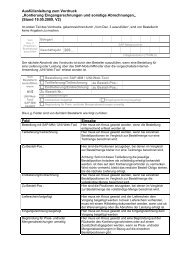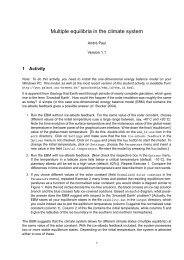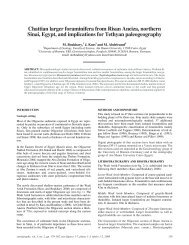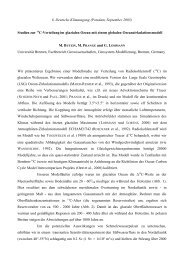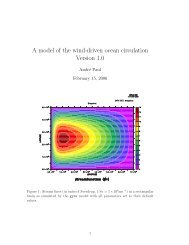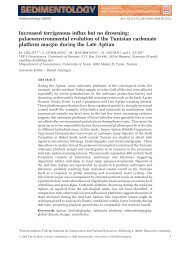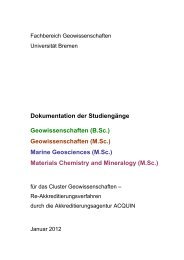Forschung im HLRN-Verbund 2011
Forschung im HLRN-Verbund 2011
Forschung im HLRN-Verbund 2011
- Keine Tags gefunden...
Erfolgreiche ePaper selbst erstellen
Machen Sie aus Ihren PDF Publikationen ein blätterbares Flipbook mit unserer einzigartigen Google optimierten e-Paper Software.
160The Higgs bosonDetermination of upper and lower Higgs boson mass bounds from a chirallyinvariant lattice Higgs-Yukawa modelM. Müller-Preussker, K. Jansen, Institut fürPhysik, Humboldt-Universität zu Berlin; NIC, DESYZeuthenAbstract• The Higgs boson is a cornerstone of particlephysics, providing masses to all quarks, leptonsand the electroweak gauge bosons.• The search for the so far undetected Higgs bosonis the main target for the Large Hadron Colliderat CERN.• Theoretically, lower and upper Higgs boson massbounds can be computed but this must be carriedout in a non-perturbative fashion.• We compute such Higgs boson mass bounds bymeans of numerical s<strong>im</strong>ulations with lattice fieldtheory techniques.• Our results provide also the energy scale wherenew physics beyond the standard model of particleinteractions has to appear.The standard model of particle physics comprisesthe electroweak and the strong interactions. Theelectroweak theory, which unifies the electromagneticand the weak interactions within a chiralgauge theory, exploits the concept of spontaneoussymmetry breaking (here known as the Higgsmechanism) to provide masses for all quarks, leptonsand the weak gauge bosons (W, Z), postulatingthe existence of the Higgs boson. However,despite of the great success of the electroweakmodel, the existence of the Higgs boson has notyet been confirmed. Thus, there is presently alarge exper<strong>im</strong>ental effort at the Large Hadron Collider(LHC) at CERN which is dedicated to the discoveryof the Higgs boson as an essential cornerstoneof the electroweak model. On the theoreticalside, a prediction of the Higgs boson mass is notpossible, but at least lower and upper bounds canbe derived. These bounds are, in principle, of nonperturbativenature. Our work focuses therefore onthe Higgs boson mass bounds which we determinenon-perturbatively employing techniques of latticefield theory, in particular Monte-Carlo s<strong>im</strong>ulations.To this end, we neglect the gauge fields, whichcan be treated perturbatively, and study a Higgs-Yukawa model, which describes the interaction betweenthe scalar and the quark fields. Such studieshave already been performed in the past but theseworks were lacking the aforementioned most <strong>im</strong>portantchiral symmetry (the interchange of masslessleft- and right-handed quarks) and no consistentHiggs-Yukawa theory could be established onthe lattice.However, recent developments in lattice fieldtheory have led to a realization of chiral symmetryon the lattice. We consider a chirally invariant latticeHiggs-Yukawa model based on the so-calledNeuberger overlap operator. With this setup, wewere able to provide fully non-perturbatively determinedupper and lower Higgs boson mass boundswhich are of direct <strong>im</strong>portance for the Higgs bosonsearch at the LHC.Our work concerning the Higgs boson massbounds have appeared in a number of publications,[1],[2],[3],[4] and contributions to international conferences.Besides the physical results, describedbelow, it needs to be stressed that a large efforthas been undertaken by us to <strong>im</strong>prove the performanceof the algorithm employed for the numericals<strong>im</strong>ulation of the model. It goes beyond the scopeof this article to discuss these <strong>im</strong>provements in detail,they can be found in the Ph.D. work of P. Gerhold,ref. [3], but it should be mentioned that theyled to a factor of 10-100 acceleration of the s<strong>im</strong>ulations.This has been an essential step to derivethe desired Higgs boson mass bounds.A most <strong>im</strong>portant role in determining the lowerand upper bounds of the Higgs boson mass isplayed by the self-interaction of the Higgs field. Itis described by a 4-point interaction multiplied by aquartic coupling λ. The value of λ has to be positivein order to have a stable theory. This leads to alower bound of the Higgs boson mass at a value ofλ = 0. On the other hand, the quartic coupling cannotexceed a value of λ = ∞ which then leads toan upper bound on the Higgs boson mass. Computingthe Higgs boson mass at λ = 0 and λ = ∞were, in fact, the strategies for deriving the desiredHiggs boson mass bounds 1 .In quantum field theories, a cut-off has to be introducedin order to render the calculations in agiven theory finite. Of course, in the end, such anunphysical cut-off has to be removed from the theory.In the here considered Higgs-Yukawa model,the removal of the cut-off leads to a peculiarity:with increasing cut-off, the strength of the Higgsself-interaction d<strong>im</strong>inishes and when the cut-off is1 It has to be remarked that the actual arguments are more involved and are usually refered to as vacuum instability for the lowerand as triviality for the upper mass bound.Physik



